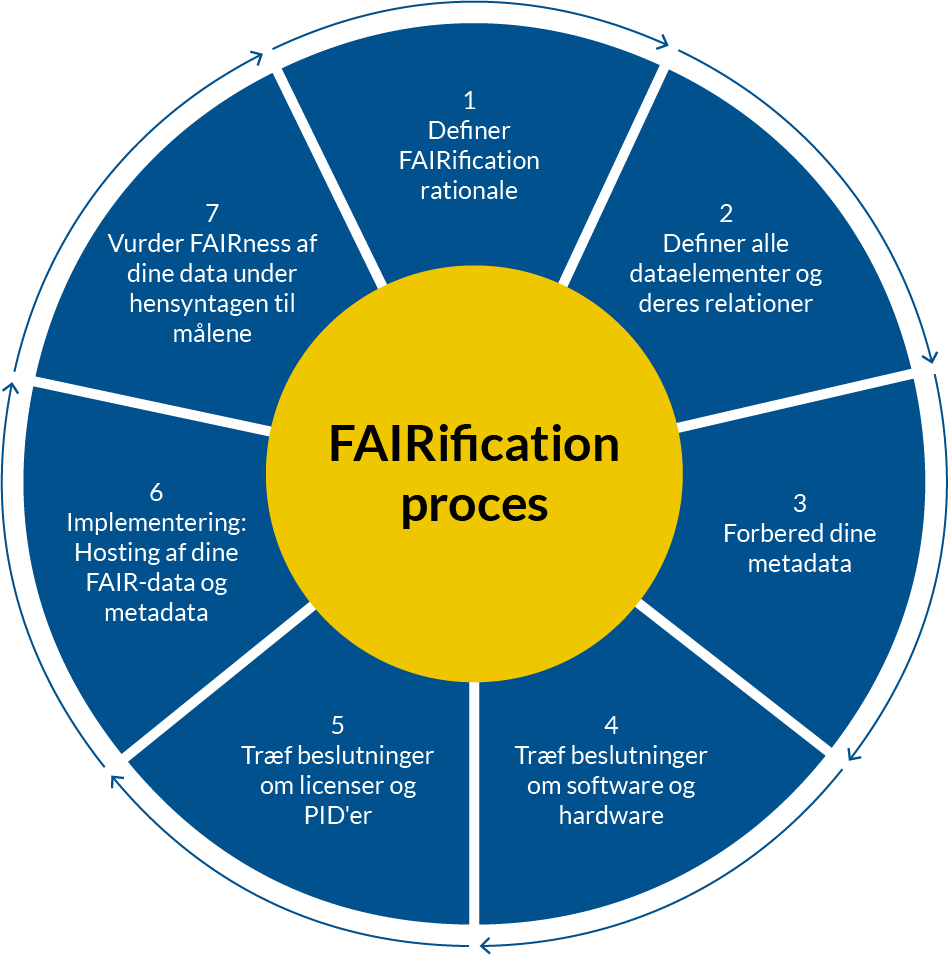GO FAIR's FAIRification process
The Danish GO FAIR office supports the implementation of the national strategy for FAIR Data Management using tools and concepts developed by GO FAIR.
The Danish GO FAIR office is part of GO FAIR international. The office aims to implement FAIR data management principles in Denmark to improve the discoverability, accessibility, interoperability and reuse of digital research assets. This is in line with the national strategy for FAIR Data Management.
GO FAIR implementation is about FAIRification initiatives in practice by research groups, communities and through GO FAIR Implementation Networks (INs) assisted by the GO FAIR International Support and Coordination Office (ISCO).
The Danish GO FAIR office aims to facilitate the Danish universities' ability to support research groups in their FAIRification initiatives. To achieve this, DeiC uses a further developed version of GO FAIR's FAIRification process. You can find it below. The process described on this page gives you more options and tools to obtain FAIR data.

1. Define the FAIRification rationale for your data
- Determine why FAIRification and/or open access to your research data should be possible. For example, if it is data to be referenced by a research publication.
- Assess FAIRness of data to determine which metrics need improvement. Not all metrics need to be perfectly met. Different research areas/groups may have different requirements and needs.
- Select datasets for FAIRification. Prioritize newly produced data and data with potential for reuse over existing data.
- Define who should have access to your data (domain-specific vs. broader audience).
As a starting point, it can help to use a FAIR evaluation tool (e.g. F-UJI or FAIR evaluator) to get an overview of the FAIR state of your data. Don't be discouraged if your data doesn't score 100%. The goal of making your data FAIR is not necessarily to get a perfect score in a FAIR evaluation tool. These tools can be very useful conversation starters and can help you think about what characteristics of your data or metadata can be adjusted to be more FAIR.
2. Define all data elements and their relationships
- Analyze the content of the data in terms of structure and concepts.
- Check if there is an existing vocabulary or ontology from your research domain available, for example in BioPortal.
- If needed, you can add elements to an existing ontology to fit your needs or build a new vocabulary.
3. Prepare your metadata
- Use an existing metadata template such as a generic metadata template structured in the DCAT organization (requires CEDAR login) or, if not available, create one preferably according to your research domain.
- Use the chosen vocabulary to describe the meaning of data elements and relationships - precisely, unambiguously, preferably in a machine-readable way to support interoperability.e.g. a Creative Commons license.
- Link metadata to datasets for example in a database.
Comprehensive and machine-readable metadata is a very important cornerstone to make your data FAIR. A Metadata for Machines (M4M) workshop (M4M by GO FAIR foundation and M4M by DeiC) can help make your metadata as FAIR as possible. During an M4M workshop, you create a machine-readable ontology for your domain-specific metadata using relatively simple tools like GoogleSheets and GitHub. To increase convergence, check if other research groups from your community have already created an ontology that you can reuse or build on, so you don't end up creating a new ontology for each small research area/group.
4. Make software and hardware decisions to support FAIRification
- Determine which database or repository your data and metadata will be stored in.
- Ensure sustainable operations (service level agreements, costing, etc.), preferably also after the initial research grant expires.
5. Make decisions about licenses and PIDs
- Decide under which license your data should be published, e.g. a Creative Commons license.
- Decide which Persistent IDentifier (PID) is right for your task, e.g. DOI.
A FAIR Implementation Profile (FIP) can help you make these decisions. Check if there are requirements from your institution or the funder of your research project.
Once you feel you have a good overview of the technical aspects of data publishing, use the FIP wizard to create your own FIP. Compare it with FIPs from other research areas/groups in your community and make adjustments to your choices to increase convergence and interoperability.
6. Implementation: Hosting your FAIR data and metadata
- Implement and test operational databases, including remote access and queries.
- Or export data to a repository suitable for hosting FAIR data.
- If you decide on a repository, look for a certified digital repository, for example with Core Trust Seal certification.
A FAIR Data Point (FDP) can be a good choice for hosting your metadata. An FDP is a metadata repository based on the DCAT organization. With just a little technical know-how (or a Data Steward in your team), you can create an FDP yourself. This allows you to have full control over your metadata, so you can make changes and updates, add new metadata, while publishing it on the web for everyone to find and reuse.
7. Assess the FAIRness of your data taking into account the goals of your FAIRification efforts
- Reassess the FAIRness of your data.
- If there is still room for improvement, repeat from the top.
Using a FAIR evaluation tool can again help you assess whether your data is FAIR. Remember, the goal is not to score 100%, but to help you think about which F-A-I-R elements are important to improve and which ones don't add much benefit in your specific case.
To learn more, contact Data Management Consultant Hannah Mihai.